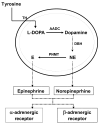Dopamine receptors: important antihypertensive counterbalance against hypertensive factors
- PMID: 21098313
- PMCID: PMC3021462
- DOI: 10.1161/HYPERTENSIONAHA.110.157727
Dopamine receptors: important antihypertensive counterbalance against hypertensive factors
Figures



References
-
- Hall JE. The kidney, hypertension, and obesity. Hypertension. 2003;41:625–633. - PubMed
-
- Hussain T, Lokhandwala MF. Renal dopamine receptors and hypertension. Exp Biol Med (Maywood) 2003;228:134–142. - PubMed
-
- Venkatakrishnan U, Chen C, Lokhandwala MF. The role of intrarenal nitric oxide in the natriuretic response to dopamine-receptor activation. Clin Exp Hypertens. 2000;22:309–324. - PubMed
-
- Khan F, Spicarová Z, Zelenin S, Holtbäck U, Scott L, Aperia A. Negative reciprocity between angiotensin II type 1 and dopamine D1 receptors in rat renal proximal tubule cells. Am J Physiol Renal Physiol. 2008;295:F1110–F1116. - PubMed
-
- Pinho MJ, Serrão MP, Gomes P, Hopfer U, Jose PA, Soares-da-Silva P. Over-expression of renal LAT1 and LAT2 and enhanced L-DOPA uptake in SHR immortalized renal proximal tubular cells. Kidney Int. 2004;66:216–226. - PubMed
Publication types
MeSH terms
Substances
Grants and funding
LinkOut - more resources
Full Text Sources
Medical

